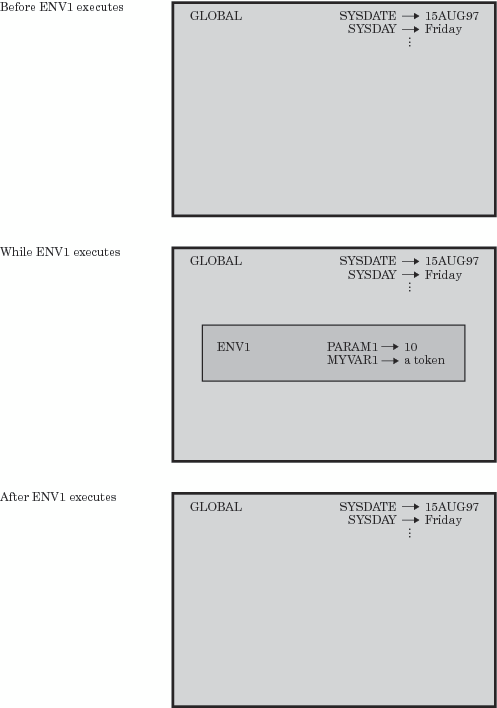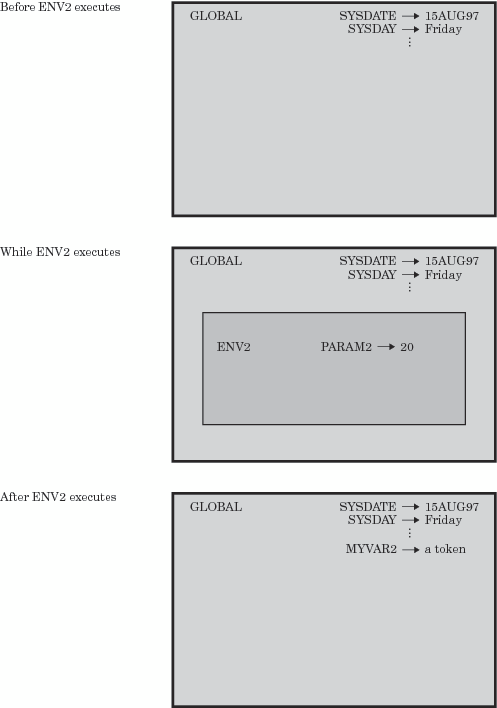Special Cases of Scope with the CALL SYMPUT Routine
Overview of CALL SYMPUT Routine
Most problems with CALL SYMPUT involve
the lack of a precise step boundary between the CALL SYMPUT statement
that creates the macro variable and the macro variable reference that
uses that variable. (For more information, see CALL SYMPUT Routine.) However, a few special cases exist that involve the scope
of a macro variable created by CALL SYMPUT. These cases are good examples
of why you should always assign a scope to a variable before assigning
a value rather than relying on SAS to do it for you.
-
However, there are three cases where CALL SYMPUT creates the variable in the local symbol table, even if that symbol table is empty:
-
If the executing macro contains a computed %GOTO statement, the variable will be created in the local symbol table. A computed %GOTO statement is one that uses a label that contains an & or a % in it. That is, a computed %GOTO statement contains a macro variable reference or a macro call that produces a text expression. Here is an example of a computed %GOTO statement:
The symbol table that
is currently available to a DATA step is the one that exists when
SAS determines that the step is complete. (SAS considers a DATA step
to be complete when it encounters a RUN statement, a semicolon after
data lines, or the beginning of another step.)
Example Using CALL SYMPUT with Complete DATA Step and a Nonempty Local Symbol Table
Consider the following example, which contains a complete
DATA step with a CALL SYMPUT statement inside a macro:
%macro env1(param1);
data _null_;
x = 'a token';
call symput('myvar1',x);
run;
%mend env1;
%env1(10)
data temp;
y = "&myvar1";
run;This message appears
because the DATA step is complete within the environment of ENV1 (that
is, the RUN statement is within the macro) and because the local symbol
table of ENV1 is not empty (it contains parameter PARAM1). Therefore,
the CALL SYMPUT routine creates MYVAR1 as a local variable for ENV1,
and the value is not available to the subsequent DATA step, which
expects a global macro variable.
To see the scopes, add
a %PUT statement with the _USER_ option to the macro, and a similar
statement in open code. Now invoke the macro as before:
%macro env1(param1);
data _null_;
x = 'a token';
call symput('myvar1',x);
run;
%put ** Inside the macro: **;
%put _user_;
%mend env1;
%env1(10)
%put ** In open code: **;
%put _user_;
data temp;
y = "&myvar1"; /* ERROR - MYVAR1 is not available in open code. */
run;When the %PUT _USER_
statements execute, they write the following information to the SAS
log:
** Inside the macro: ** ENV1 MYVAR1 a token ENV1 PARAM1 10 ** In open code: **
Example Using CALL SYMPUT with an Incomplete DATA Step
In the macro ENV2, shown
here, the DATA step is not complete within the macro because there
is no RUN statement:
%macro env2(param2);
data _null_;
x = 'a token';
call symput('myvar2',x);
%mend env2;
%env2(20)
run;
data temp;
y="&myvar2";
run;These statements execute
without errors. The DATA step is complete only when SAS encounters
the RUN statement (in this case, in open code). Thus, the current
scope of the DATA step is the global scope. CALL SYMPUT creates MYVAR2
as a global macro variable, and the value is available to the subsequent
DATA step.
%macro env2(param2);
data _null_;
x = 'a token';
call symput('myvar2',x);
%put ** Inside the macro: **;
%put _user_;
%mend env2;
%env2(20)
run;
%put ** In open code: **;
%put _user_;
data temp;
y="&myvar2";
run;When the %PUT _USER_
statement within ENV2 executes, it writes the following to the SAS
log:
** Inside the macro: ** ENV2 PARAM2 20
Example Using CALL SYMPUT with a Complete DATA Step and an Empty Local Symbol Table
In the following example, ENV3 does not use macro parameters. Therefore,
its local symbol table is empty:
%macro env3;
data _null_;
x = 'a token';
call symput('myvar3',x);
run;
%put ** Inside the macro: **;
%put _user_;
%mend env3;
%env3
%put ** In open code: **;
%put _user_;
data temp;
y="&myvar3";
run;Example Using CALL SYMPUT with SYSPBUFF and an Empty Local Symbol Table
In the following example, the presence of the SYSPBUFF
automatic macro variable causes CALL SYMPUT to behave as if the local
symbol table were not empty, even though the macro ENV4 has no parameters
or local macro variables:
%macro env4 /parmbuff;
data _null_;
x = 'a token';
call symput('myvar4',x);
run;
%put ** Inside the macro: **;
%put _user_;
%put &syspbuff;
%mend env4;
%env4
%put ** In open code: **;
%put _user_;
%put &syspbuff;
data temp;
y="&myvar4"; /* ERROR - MYVAR4 is not available in open code */
run;The presence of the
/PARMBUFF specification causes the SYSPBUFF automatic macro variable
to be created. So, when you call macro ENV4, CALL SYMPUT creates the
macro variable MYVAR4 in the local symbol table (that is, in ENV4's),
even though the macro ENV4 has no parameters and no local variables.
The results of the %PUT
statements prove this—the score of MYVAR4 is listed as ENV4,
and the reference to SYSPBUFF does not resolve in the open code %PUT
statement because SYSPBUFF is local to ENV4:
** Inside the macro: ** b ENV4 MYVAR4 a token ** In open code: ** WARNING: Apparent symbolic reference SYSPBUFF not resolved.
For more information,
see SYSPBUFF Automatic Macro Variable.

